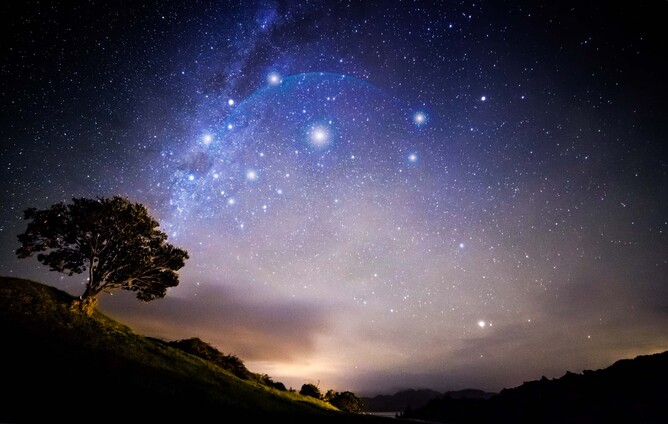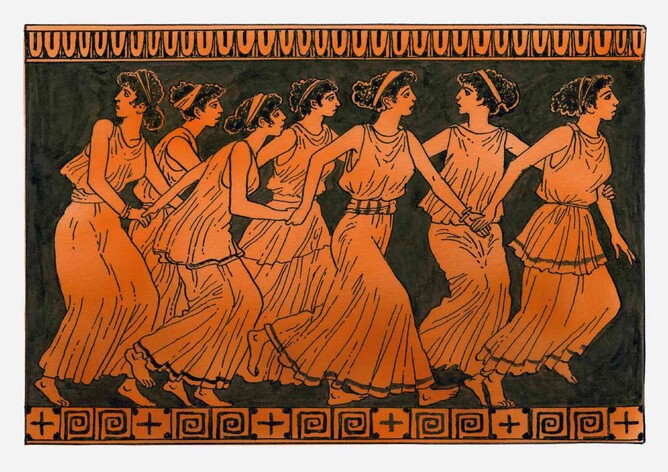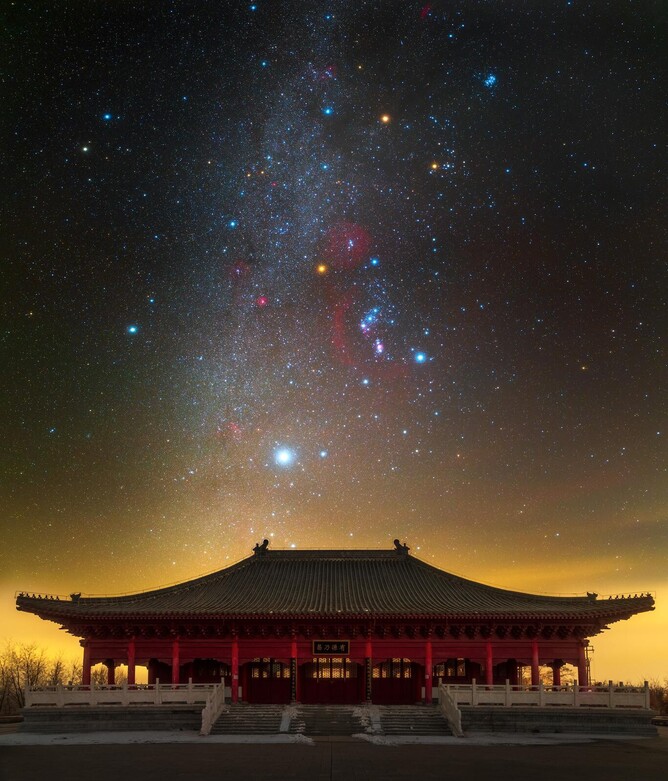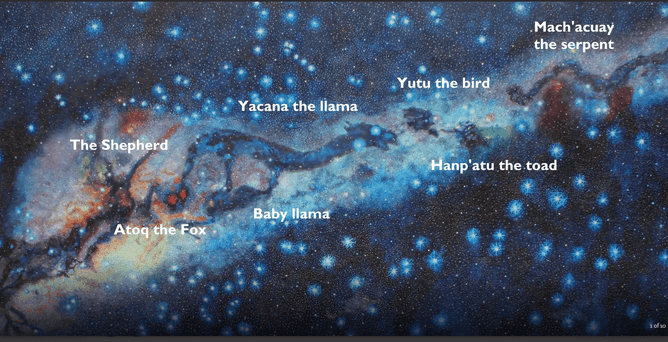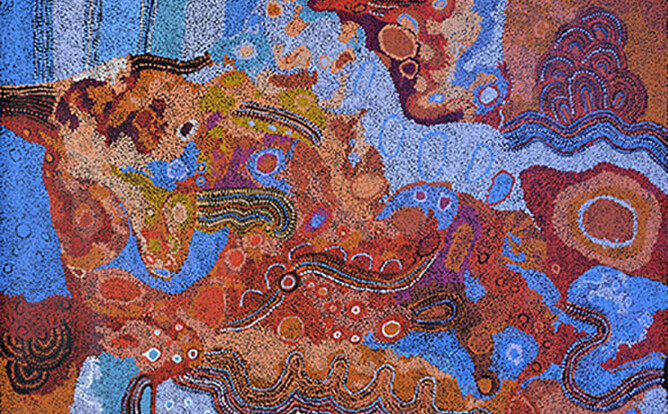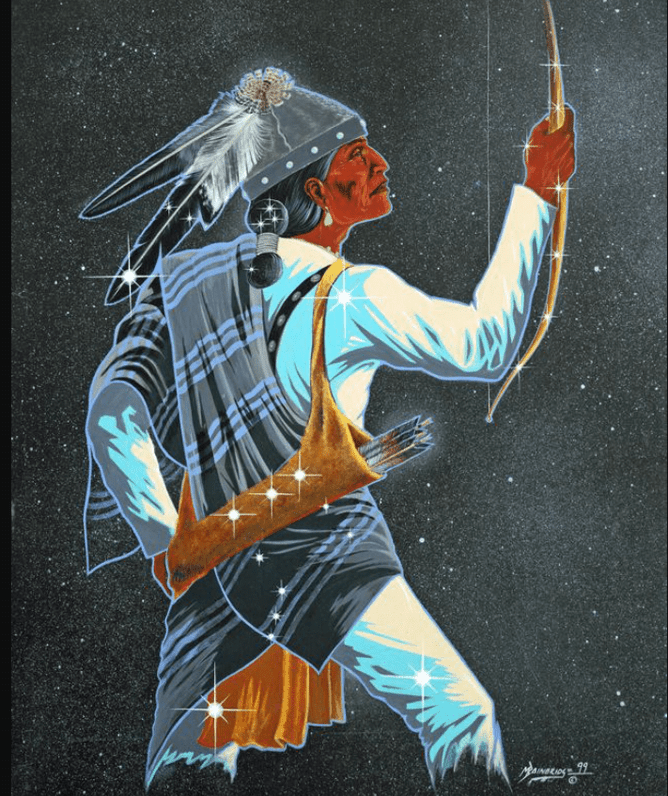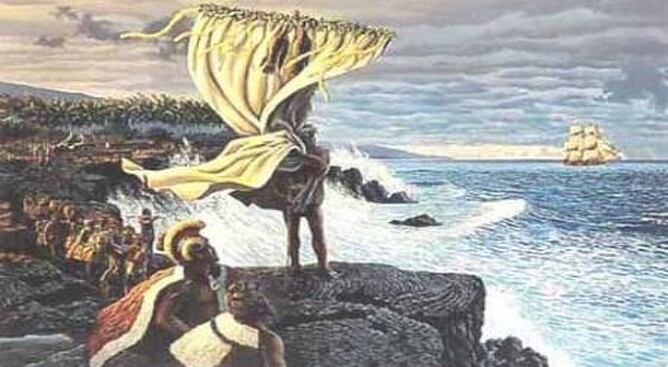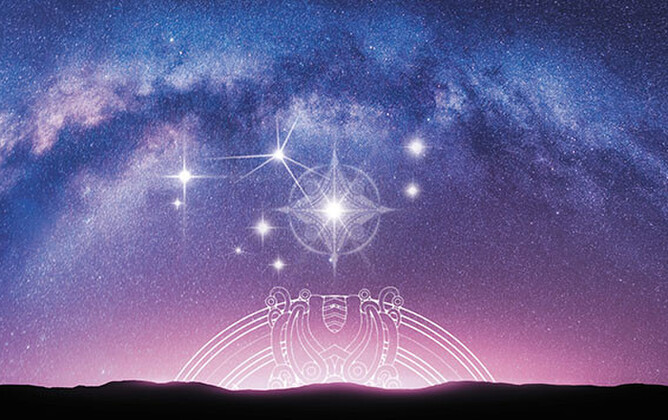The Pleiades star cluster, also known as the Seven Sisters, has fascinated humanity for millennia
The Pleiades star cluster, known as the Seven Sisters, resonates deeply across diverse cultures worldwide.
Celebrated for its symbolic unity and familial bonds, the Pleiades serve as both mythological figures and practical guides.
In Greek mythology, they are pursued by Orion; in Japanese culture, they symbolize unity (Subaru).
Agriculturally, they mark planting and harvesting seasons in cultures like the Inca, Hawaiian, and Australian Aboriginal.
Spiritually, they influence rituals and celebrations, from Hawaiian Makahiki to Maori Matariki, fostering community and gratitude.
As navigational aids, they guided Pacific Islanders, showcasing their universal significance in connecting humanity through shared myths, practices, and celestial wonder.
The Pleiades in Greek Mythology: The Story of the Seven Sisters
The Pleiades star cluster, known as the Seven Sisters in Greek mythology, is a captivating blend of myth and astronomy
The Pleiades star cluster, known as the Seven Sisters in Greek mythology, is a captivating blend of myth and astronomy. Their story reflects themes of family, transformation, and eternal pursuit, connecting human experiences with the celestial realm.
In Greek mythology, the Pleiades are seven sisters: Maia, Electra, Taygete, Alcyone, Celaeno, Sterope, and Merope. These sisters are the daughters of the Titan Atlas, who holds up the sky, and the ocean nymph, Pleione.
The Greek tale of the Pleiades is one of beauty, tragedy, and celestial splendor
1. Maia: The eldest and most beautiful of the sisters, Maia is the mother of Hermes, the messenger god, with Zeus. She is often depicted as a nurturing and protective figure.
2. Electra: Known for her grace and beauty, Electra is the mother of Dardanus and Iasion with Zeus. Dardanus is credited with founding the city of Troy.
3. Taygete: Taygete is associated with the region of Sparta. She bore Lacedaemon, the mythical founder of Sparta, with Zeus.
4. Alcyone: Alcyone, often associated with tranquility, is the wife of Ceyx. Their tragic love story involves their transformation into birds by the gods after Ceyx's death.
5. Celaeno: Known for her darker aspects, Celaeno bore several children with Poseidon, including Lycus and Eurypylus.
6. Sterope: Also known as Asterope, she bore Oenomaus, a prominent figure in Greek myths, with Ares, the god of war.
7. Merope: The youngest sister, Merope, married a mortal, King Sisyphus of Corinth. Her marriage to a mortal is said to be the reason she appears dimmer in the sky, out of shame.
The Pursuit by Orion
A central part of the Pleiades' myth is their connection to the giant hunter Orion.
According to legend, Orion fell in love with the sisters and pursued them relentlessly. To protect them, Zeus transformed the sisters into stars and placed them in the sky. However, Orion was also placed among the stars, continuing his pursuit across the heavens.
This celestial chase is visible in the night sky, where the constellation of Orion follows the Pleiades. The myth captures themes of protection, transformation, and the eternal dance between the hunter and the hunted.
The Role of the Pleiades in Greek Culture
The Pleiades were not only mythological figures. They also had practical significance in Greek culture.
Their appearance in the sky signaled the start of the sailing season and the time for planting and harvesting. The Greeks saw the Pleiades as harbingers of change, guiding agricultural and navigational activities.
The Pleiades in Japanese Culture: The Tale of Subaru
In Japanese culture, the Pleiades star cluster is known as Subaru, which translates as - to unite or cluster together
In Japanese culture, the Pleiades star cluster, known as Subaru, symbolizes unity, cooperation, and harmony.
Whether inspiring a major car brand or marking important agricultural cycles, Subaru's representation of the Pleiades highlights the deep connection between the stars and the values that guide Japanese society.
The Pleiades continue to shine brightly, reminding us of the beauty and strength found in unity.
Subaru embodies the idea of unity and connection, themes that are deeply embedded in Japanese culture
The clustering of the Pleiades stars in the night sky symbolizes how individual elements come together to form a cohesive and harmonious whole.
This is a principle that resonates strongly with the values of community, cooperation, and collective effort in Japanese society.
The Subaru Car Brand
One of the most prominent modern-day representations of the Pleiades in Japanese culture is the Subaru car brand. The company's logo features six stars, representing the visible stars of the Pleiades cluster.
The choice of this symbol signifies unity and the bringing together of diverse elements to create something greater—a powerful car brand that combines innovation, reliability, and performance.
This connection to the Pleiades underscores the brand's emphasis on unity and excellence.
The Pleiades in Japanese agriculture and festivities
Their rising in the sky was traditionally seen as a marker for important agricultural activities, much like in other cultures around the world. This celestial event indicated the time for planting and harvesting, linking the stars to the rhythms of nature and daily life.
The spiritual significance of Subaru extends to various aspects of Japanese life
The stars are often seen as celestial guides, providing a sense of direction and purpose.
They are a reminder of the interconnectedness of all things and the importance of working together harmoniously. The Pleiades also appear in various Japanese arts and literature, reflecting their enduring place in the cultural imagination.
The Pleiades in the Inca Culture - fascinating facts
In the Inca civilization, the Pleiades star cluster was known as Collca
In the Inca civilization, the Pleiades star cluster was known as Collca. The Incas held these stars in high regard, viewing them as important celestial markers.
The Pleiades, or Collca, were a vital part of Inca culture, intertwining astronomy, agriculture, and spirituality into a cohesive and meaningful whole.
Agricultural Significance
The rising of the Pleiades marked crucial times for agricultural activities. Their appearance in the night sky signaled the beginning of the planting season, while their disappearance indicated the time for harvesting. This helped the Incas in planning their farming cycles effectively.
Symbol of Fertility and Abundance
The Pleiades were seen as symbols of fertility and abundance.
Their bright, clear presence was interpreted as a sign of a bountiful season ahead, ensuring that crops would grow plentifully and sustain the community.
Spiritual and Religious Importance
The Incas believed the Pleiades were deities watching over them, providing guidance and protection. The star cluster played a role in their spiritual and religious practices, linking the heavens with their everyday lives.
Cultural Celebrations
The appearance of the Pleiades was often celebrated with festivals and rituals, expressing gratitude to the gods for the promise of good harvests and the well-being of their society.
The Pleiades in Australian Aboriginal Culture - the Seven Sisters
The Seven Sisters are central to numerous Dreamtime stories and myths across different Aboriginal groups.
Known as the Seven Sisters
In many Australian Aboriginal cultures, the Pleiades are referred to as the Seven Sisters.
These stars are central to numerous Dreamtime stories and myths across different Aboriginal groups.
Dreamtime Stories
The Seven Sisters are often depicted as a group of ancestral women pursued by a man, mirroring the Greek myth of Orion and the Pleiades.
These stories vary among different Aboriginal groups but generally involve themes of pursuit, escape, and transformation.
The Pleiades hold significant cultural and spiritual importance
They are often associated with women's stories, ceremonies, and laws.
In some traditions, the Seven Sisters are seen as creators and custodians of sacred women's business.
Seasonal Indicators
The appearance and position of the Pleiades in the sky are used to mark seasonal changes and guide agricultural and hunting activities e.g. their rise might indicate the time to harvest certain plants or the start of particular animal migrations.
Art and Storytelling
The Seven Sisters feature prominently in Aboriginal art, including rock paintings, carvings, and contemporary artworks. These artistic expressions help preserve and communicate the rich mythology and cultural heritage associated with the Pleiades.
The Pleiades, or Seven Sisters, are an integral part of Australian Aboriginal culture, embodying deep spiritual beliefs, guiding seasonal practices, and enriching the cultural landscape through stories and art.
To the Navajo, Cherokee and Lakota Sioux, the Pleiades are the Seven Sisters or Dancing Stars
The Pleiades, or Seven Sisters, are revered in Native American cultures for their spiritual significance
They inspire rich storytelling traditions and artistic expressions that symbolize unity and the interconnectedness of life.
These stars also serve as navigational aids and timekeepers, supporting traditional practices and fostering a deep connection to nature among Indigenous communities across North America.
Mythological Stories
In Native American traditions, such as those of the Navajo, Cherokee, and Lakota Sioux, the Pleiades are often referred to as the "Seven Sisters" or "Dancing Stars."
These stars are associated with stories of creation, migration, and celestial beings. For example, the Navajo see them as the "Sparkling Suns" and link them to the origins of their people.
Agricultural and Seasonal Cycles
The Pleiades serve as markers for seasonal changes, guiding agricultural practices. They indicate times for planting, harvesting, and preparing for winter.
Their appearance in the sky is closely monitored to ensure timely cultivation of crops and adherence to traditional farming practices.
Spiritual Significance
The Pleiades are revered as ancestral spirits or deities in many Native American cultures.
They are seen as protectors and guides, offering wisdom and blessings to the people.
Ceremonies and rituals are held to honor and communicate with these celestial beings, seeking their guidance for communal well-being.
Art and Symbolism
The Pleiades feature prominently in Native American art and symbolism. They are depicted in pottery, textiles, and jewelry, often as a symbol of unity, harmony, and the interconnectedness of all living beings.
Their enduring presence in artistic expression reflects their cultural significance and spiritual influence.
5. Navigational and Timekeeping Role: Historically, the Pleiades were used for navigation and as a celestial calendar. Their movements across the night sky marked important seasonal changes and guided hunting and gathering expeditions, reinforcing their practical importance in daily life.
Makahiki - The Pleiades in Hawaiian Culture
Makahiki, hold a special place in Hawaiian culture, symbolizing renewal, peace, and the cyclical nature of life
In Hawaiian culture, the Pleiades star cluster is known as Makahiki. This period is significant for marking the beginning of the Hawaiian New Year.
The Pleiades, or Makahiki, hold a special place in Hawaiian culture, symbolizing renewal, peace, and the cyclical nature of life.
Season of Peace and Harvest
The Makahiki season is a time of peace, rest, and celebration. During this time, all wars were forbidden, and people focused on feasting, games, and paying tribute to the gods.
Honoring Lono
Makahiki is dedicated to Lono, the god of agriculture, fertility, rain, and peace.
The appearance of the Pleiades signals the start of the Makahiki festival, which includes various rituals and offerings to honor Lono.
Agricultural Guidance
Similar to other cultures, the Pleiades were crucial for guiding agricultural activities.
The cluster's rise in the sky indicated the time to harvest and prepare for the next planting season.
Community and Gratitude
Makahiki was a time for communities to come together, give thanks for the year's bounty, and ensure that everyone had enough provisions.
It emphasized unity, gratitude, and the importance of living in harmony with nature.
In Tahitian culture, the Pleiades star cluster is known as Matari'i
The rising of Matari'i in Tahiti signals the time when food resources, particularly fish and crops, are plentiful
While there are similarities in the way Tahiti and Hawaii celebrate the Pleiades, such as their agricultural significance and communal festivities, each culture has its own unique customs and interpretations.
Both reflect a deep connection to the stars and the natural world, celebrating the cyclical nature of life and the abundance provided by the earth and sea.
Agricultural Significance
Like in Hawaiian culture, the appearance of the Pleiades (Matari'i) in Tahiti marks important agricultural cycles. It signifies the end of the dry season and the beginning of the fertile rainy season, guiding the timing of planting and harvesting.
Season of Abundance
Both cultures associate the Pleiades with a period of abundance.
The rising of Matari'i in Tahiti signals the time when food resources, particularly fish and crops, are plentiful.
Cultural Celebrations
In both Tahitian and Hawaiian cultures, the appearance of the Pleiades is celebrated with festivals and rituals. These celebrations often include feasting, music, dance, and communal activities.
Deity Association
While the Hawaiian Makahiki season is dedicated to Lono, the god of agriculture, fertility, and peace, Tahitian celebrations are focused more broadly on the connection between the stars and the natural cycles of life.
In Tahiti, Matari'i marks two significant periods in the traditional calendar
Matari'i i ni'a (the season of plenty) and Matari'i i raro (the season of scarcity).
The celebrations and rituals are closely tied to these periods, emphasizing the shifts in natural resources and community practices.
In Hawaii, Makahiki is a continuous season of peace and festivities.
Cultural Context
The Tahitian Matari'i celebrations are deeply influenced by the island's maritime culture and the importance of the ocean.
In Samoa, the Pleiades are called Mata-ali’i
Mata-ali’i is associated with navigation and the timing of fishing and planting
In Samoa, the Pleiades are called Mata-ali’i, and in Tahiti, they are Matarii’i.
These names are associated with navigation and the timing of fishing and planting.
The stars guided ancient Polynesians across the vast Pacific Ocean, symbolizing guidance, exploration, and survival.
